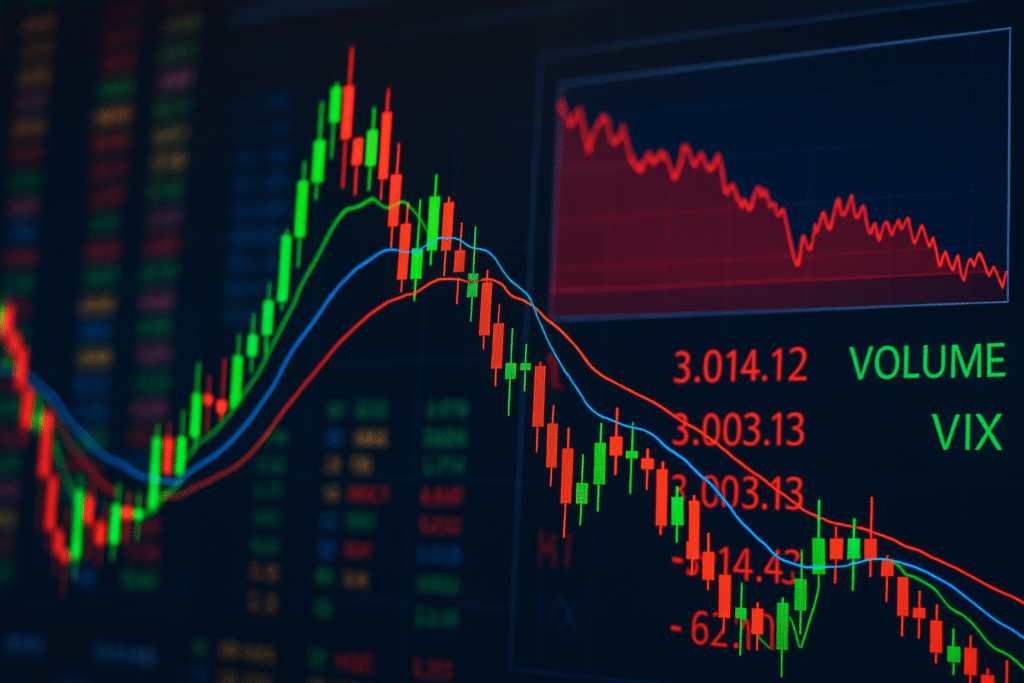Ever watched your portfolio drop 10% in a week while your friend panic-sold everything? Meanwhile, the investor next door somehow made money during the same market nosedive. What’s their secret? It often comes down to understanding market volatility benefits—and knowing how to leverage them rather than fear them.
Sure, most financial advisors tell you to “stay the course” during market volatility—but that’s only half the story. Savvy investors don’t just endure market swings; they position themselves to thrive on market turbulence opportunities. Survival is baseline. Profit is the play.
Market volatility isn’t just a roller coaster for your emotions and investment returns. When handled strategically, it creates wealth-building opportunities that simply don’t exist in stable markets.
But here’s what separates the amateur investors from the pros: understanding exactly which volatility signals represent danger… and which ones are practically flashing neon “BUY NOW” signs. The difference might shock you. This guide on market volatility from Fidelity breaks it down in simple, actionable terms.
Understanding Market Volatility: Friend or Foe?

What exactly is market volatility and how is it measured
Market volatility is simply the rate at which prices swing up and down. Think of it as the market’s mood swings – sometimes mild, sometimes wild.
When investors talk about volatility, they’re referring to how much stock prices deviate from their average. Higher volatility means bigger price swings in either direction.
The most common measurement of volatility is the VIX index—nicknamed the “fear gauge.” It tracks expected volatility in the S&P 500 over the next 30 days. When the VIX is high (above 30), markets are jittery. When it’s low (below 20), markets are relatively calm. For a deeper dive into tools beyond the VIX, check out this breakdown of top volatility indicators from IG.
Other ways to measure volatility include:
- Standard deviation: How far prices scatter from their average
- Beta: How volatile a stock is compared to the overall market
- Average True Range (ATR): The average price range over a specific period
The psychological impact of volatility on investors
Volatility messes with our heads. It’s that simple.
Understandably, when markets plunge, our rudimentary brain screams “danger!” and urges us to flee. This fight-or-flight response overrides logic in favor of survival instincts. That’s why even the most rational investors panic-sell during downturns—locking in losses they might have dodged. Recognizing this psychological trap is part of mastering market fluctuation rewards: staying calm while others unravel.
The human brain hates uncertainty. We’re wired to find patterns and make predictions. Market volatility disrupts this, creating anxiety and stress.
Studies show investors feel the pain of losses about twice as intensely as they enjoy equivalent gains. This “loss aversion” explains why market drops hurt so much emotionally—but it’s also why understanding market volatility benefits can help re-frame those dips as strategic entry points, not just emotional pitfalls.
The psychological roller coaster looks something like this:
- Initial market drop → Fear and anxiety
- Continued decline → Panic and capitulation
- Market stabilization → Relief but lingering doubt
- Recovery → Regret (if you sold) or vindication (if you held)
How volatility creates opportunities in financial markets
Volatility isn’t just something to survive – it’s something smart investors exploit.
Market turbulence creates pricing inefficiencies. When investors panic-sell quality assets, prices can disconnect from fundamental values. This creates buying opportunities for those with cash and courage.
Volatility also:
- Increases option premiums: Options traders make more money selling options during volatile periods
- Creates trading opportunities: Price swings create more entry and exit points
- Provides better dividend yields: Stock price drops while dividends remain constant means higher yield
- Makes dollar-cost averaging more effective: Buying regularly through volatility means catching more shares at lower prices
Professional traders actually prefer volatile markets. A market that barely moves offers few chances to profit. A choppy market creates opportunities for those who know how to navigate it.
Common misconceptions about market fluctuations
Contrary to popular belief, “Volatility always means the market is crashing.” Nope. Volatility cuts both ways—prices can just as easily surge as they can plunge. In fact, some of the biggest one-day gains happen during periods of intense market fluctuation opportunities. Miss those days, and you miss the bounce.
“Low volatility means safe markets.” Wrong again. Extended periods of low volatility often lead to complacency and risk-taking, setting the stage for major corrections.
“You can’t make money during volatile markets.” Tell that to hedge funds and volatility traders who thrive on chaos. They’re masters at spotting market volatility benefits—turning turbulence into timing, and swings into strategy. Volatility doesn’t just shake the market; it shakes loose opportunity.
“Market volatility is always bad for your portfolio.” Not necessarily. If you’re regularly investing for the long term, volatility allows you to purchase assets at better prices through dollar-cost averaging.
“High volatility is the new normal.” Markets have always been volatile. While technology can accelerate price movements, the fundamental pattern of market cycles remains unchanged.
Volatility isn’t your enemy – it’s just a feature of markets that rewards preparation and punishes panic.
The Hidden Benefits of Volatile Markets

A. Price discounts on quality assets during downturns
Market crashes aren’t just doom and gloom – they’re essentially massive sales on quality stocks. Think about it: when everyone’s panicking, good companies get dumped alongside the bad ones.
Warren Buffett nailed it when he said to “be fearful when others are greedy, and greedy when others are fearful.” This isn’t just cute investment advice – it’s a wealth-building strategy that’s created billionaires.
During the March 2020 COVID crash, Amazon plunged roughly 30%—despite booming demand from lockdown-driven online shopping. Investors who bought near the bottom saw a rebound of about 60% by year-end. According to Investopedia, Amazon was one of 2020’s standout stock performers, benefiting massively from shifting consumer behavior.
Therefore, the trick is having cash ready when opportunity knocks. Keep some powder dry—say, 10–15% of your portfolio in cash or short-term bonds—so you’re ready to strike when the market throws a tantrum. It’s a tactical way to tap into market turbulence advantages with speed and precision.
B. Enhanced income generation through increased premiums
When markets get choppy, option premiums skyrocket. This is where options sellers make serious bank.
During calm markets, selling covered calls might net you 0.5–1% monthly. But when volatility spikes, those same strategies can deliver 2–3% monthly returns. That’s the power of market volatility benefits—transforming steady plays into high-yield tactics. We’re talking the difference between 6% and 36% annualized, all without taking on extra risk.
Consider this real-world example: In late 2022, Tesla options were paying premiums that would make loan sharks blush. Investors selling covered calls or cash-secured puts were earning 3-5% monthly income while waiting to buy or sell at their desired prices.
Income investors who understand volatility don’t fear it – they feast on it.
C. Portfolio re-balancing advantages during market swings
Volatility creates natural re-balancing opportunities that actually boost returns over time.
Here’s the magic: When markets swing wildly, your portfolio naturally drifts from your target allocation. By systematically re-balancing – selling what’s gone up to buy what’s gone down – you’re essentially forcing yourself to buy low and sell high.
A study by Vanguard found that disciplined rebalancing added about 0.4% annually to portfolio returns—that’s an extra $40,000 on a $1 million portfolio over 10 years. Cordant Wealth breaks down the findings here, showing how a simple strategy can quietly compound into serious gains.
The beauty of this strategy? It takes emotion completely out of the equation. You’re not trying to time the market – you’re just maintaining your desired allocation and letting volatility do the heavy lifting.
D. Higher potential returns as compensation for volatility risk
There’s a reason volatile assets generally deliver better long-term returns – you’re getting paid for the emotional roller-coaster.
Meanwhile, take a closer look at small-cap stocks. They’re infamous for gut-wrenching swings—but historically, they’ve outpaced large-caps by roughly 2% annually. Over 30 years, that’s not pocket change—it’s the difference between $100,000 growing into $761,000 versus $1.8 million. It’s a high-volatility case study in long-term market fluctuation rewards.
Emerging markets tell the same story. Sure, they might drop 30% when global markets sneeze—but over the long haul, they’ve outperformed developed markets. It’s a textbook example of market volatility benefits: higher risk, yes, but historically paired with outsized, compounding rewards.
The market isn’t giving you these higher returns out of generosity – it’s compensating you for enduring the volatility that sends most investors running for the exits.
E. Creating wealth transfer opportunities for long-term investors
Volatility creates the perfect environment for wealth transfer – from the impatient to the patient.
When markets plunge, short-term traders and leveraged investors get forced out at precisely the wrong time. Their pain becomes your gain as high-quality assets change hands at fire-sale prices.
Tax-loss harvesting during volatile periods can also significantly boost after-tax returns. By selling losers to offset gains, investors can save thousands in taxes while maintaining market exposure through similar (but not identical) investments.
For estate planning, volatility creates windows to transfer depreciated assets to heirs, potentially saving substantial amounts in estate taxes while positioning the next generation to capture the eventual recovery.
Strategic Approaches to Capitalize on Market Turbulence

Value investing during market corrections
Market corrections scare off amateur investors. But for value hunters, they’re a store-wide clearance sale. This is where market volatility benefits come into play—dropping prices not because assets are broken, but because sentiment is. Smart investors know: volatility doesn’t erase value; it discounts it.
Consequently, when markets tumble, even solid companies with strong fundamentals often get pulled down with the rest. This creates a golden opportunity to scoop up quality stocks at discounted prices. It’s one of the clearest market turbulence opportunities—and Buffett said it best: “Be fearful when others are greedy, and greedy when others are fearful.”
During the March 2020 COVID crash, companies like Apple dropped nearly 30% before rebounding to all-time highs within months. Investors who recognized the disconnect between price and value scored big.
The key is doing your homework:
- Look for companies with low debt, strong cash flows, and competitive advantages
- Calculate intrinsic value using metrics like P/E ratio, price-to-book, and discounted cash flow
- Set target entry prices before corrections happen
- Keep a watchlist of quality companies you’d love to own “on sale”
Don’t try timing the bottom perfectly. Instead, stage your entries as markets decline. Remember that value investing during volatility isn’t about quick profits—it’s about buying great businesses at prices that virtually guarantee long-term returns.
Momentum trading techniques in high-volatility environments
Volatile markets create massive price swings that momentum traders can ride to impressive profits. Unlike value investors who zig when the market zags, momentum traders amplify the prevailing trend.
That said, the strategy sounds deceptively simple: buy what’s rising, sell what’s falling. But in high-volatility environments, execution is everything. This is where volatility investing strategies reward the disciplined—those with iron-clad rules and nerves of steel. Because in chaos, timing isn’t just important—it’s the whole game.
Some proven techniques:
- Relative strength trading: Focus on stocks outperforming benchmark indices, as they’ll likely continue outperforming
- Breakout trading: Enter positions when prices break through key resistance levels on high volume
- Moving average strategies: Use crossovers of short and long-term moving averages to confirm trend direction
Risk management becomes even more crucial in volatile markets. Successful momentum traders:
- Set strict stop-losses (often using ATR-based calculations)
- Scale position sizes down as volatility increases
- Take partial profits at predetermined targets
- Never chase entries after missing planned entry points
The 2020-2021 market provided textbook examples, with stocks like Tesla and Zoom riding momentum waves to deliver triple-digit returns in months. The same principles work in reverse during downtrends—just ask traders who shorted overvalued tech stocks in 2022.
Options strategies that thrive on market uncertainty
Options aren’t just for speculation—they’re powerful tools specifically designed to profit from volatility itself.
When markets get choppy, option premiums inflate—driven by uncertainty. That’s prime time for strategies that don’t bet on direction, but on movement itself. It’s another angle of market volatility benefits: getting paid more for the same exposure, simply because the crowd’s nervous.
Some of the most effective approaches:
Selling covered calls: Generate extra income on stocks you already own by selling call options against your positions. The higher premiums during volatile periods boost your yield.
Iron condors: Profit when prices stay within a range, even a wide one. This strategy combines two credit spreads and works best when volatility is high but expected to decrease.
Straddles and strangles: Buy both put and call options to profit from big moves in either direction. These are perfect for events like earnings reports or Fed announcements.
Volatility-specific trades: Use VIX options or volatility ETFs to directly trade market sentiment rather than price direction.
For instance, during the 2020 market crash, the VIX (volatility index) soared above 80. Traders who sold put credit spreads on high-quality stocks not only raked in oversized premiums—they also positioned themselves to scoop up shares at fire-sale prices if assigned. It’s a classic display of how to harness market fluctuation advantages amid the chaos.
The beauty of options is their flexibility—you can design strategies to profit in any market condition.
Dollar-cost averaging to harness volatility’s power
The simplest strategy might actually be the most powerful for long-term investors: dollar-cost averaging (DCA). It transforms market volatility from something to fear into a secret weapon for building wealth.
Dollar-cost averaging (DCA) means investing fixed amounts at regular intervals—no matter the price. When markets drop, your money buys more shares; when they rise, you snag fewer. Over time, this cushions the ride and lowers your average cost per share. It’s a quiet way to harness market volatility benefits without needing a crystal ball or perfect timing.
Here’s what makes DCA especially effective during volatile periods:
- It removes emotion from investing decisions
- You systematically buy more at lower prices (without having to time the market)
- It creates discipline that prevents panic selling at bottoms
- It eliminates the stress of trying to pick perfect entry points
Consider two investors during the 2008-2009 financial crisis. The lump-sum investor put $10,000 into an S&P 500 index fund at the “seemingly low” price in November 2008. The DCA investor put in $1,000 monthly for 10 months. By the end of that period, the DCA investor had a significantly lower average cost basis and higher returns when markets recovered.
Ultimately, for most non-professional investors, this approach outperforms the stress of trying to outguess market swings. Paired with automatic investments, it puts your financial growth on autopilot—turning market fluctuation opportunities into allies rather than enemies.
Building a Volatility-Ready Investment Portfolio

Asset allocation strategies for different volatility regimes
Volatility isn’t a one-size-fits-all game. Smart investors adapt their asset mix based on market conditions. When markets are calm, you might lean heavier into stocks to capture growth. During choppy waters, shifting more into bonds can help you sleep at night.
Consider this practical approach:
| Volatility Regime | Stocks | Bonds | Cash | Alternatives |
|---|---|---|---|---|
| Low Volatility | 70% | 20% | 5% | 5% |
| Medium Volatility | 55% | 30% | 10% | 5% |
| High Volatility | 40% | 40% | 15% | 5% |
The trick? Don’t wait until markets crash to make changes. Set triggers in advance – maybe when the VIX hits certain levels or when your portfolio drifts more than 5% from your targets.
Defensive investments that provide stability during storms
When markets go wild, some investments act like shock absorbers for your portfolio. They won’t steal the spotlight, but they’re the financial equivalent of comfort food—steady, grounding, essential. Embracing these during turbulent times highlights one of the quieter market volatility benefits: stability isn’t boring when everything else is breaking.
High-quality bonds (especially government bonds) still reign supreme as volatility hedges. They often move opposite to stocks when fear strikes.
Cash isn’t trash during market meltdowns – it’s dry powder. Having 10-15% ready to deploy when others panic can set you up for years of gains.
Dividend aristocrats – companies that have increased dividends for 25+ years straight – tend to weather storms better than their flashier counterparts.
Granted, consumer staples and utilities rarely steal the spotlight—but people still need toothpaste and electricity, even in a recession. These sectors quietly showcase market turbulence advantages: resilient demand, steady cash flow, and the kind of consistency that shines when everything else falters.
Offensive positions to capture upside during recovery periods
The best time to be aggressive? When everyone else is scared silly.
Quality growth stocks trading at temporary discounts are like buying designer clothes at outlet prices. Look for companies with strong balance sheets, competitive advantages, and reasonable debt levels.
Cyclical sectors (think consumer discretionary, industrials) get hammered during downturns but often lead the charge when recovery begins. Buying these when blood is in the streets takes guts but historically pays off.
Small-cap stocks typically get crushed harder during volatility spikes but can deliver explosive returns during recoveries. They’re the first to get dumped and often the first to rebound.
Options strategies like selling puts on quality companies you’d love to own anyway can be a win-win—earning you income while setting you up to buy at a discount. It’s a clever way to tap into market volatility benefits, turning short-term uncertainty into long-term value plays.
Alternative investments with low correlation to traditional markets
The secret weapon in volatility-ready portfolios? Assets that dance to their own beat.
Real estate investment trusts (REITs) focused on data centers or healthcare facilities often move differently than broad market indexes.
Commodities – especially precious metals like gold – can shine when everything else looks dim. They’re not perfect inflation hedges, but they add valuable diversification.
Market-neutral hedge fund strategies aim to profit regardless of market direction, making them potential portfolio stabilizers.
Infrastructure investments (think toll roads, utilities) generate steady cash flows regardless of economic conditions – people still need water and electricity.
Private equity, while illiquid, can provide returns uncorrelated with public markets, though access remains challenging for average investors.
Re-balancing frequency considerations in volatile conditions
When markets go haywire, your standard annual re-balance might not cut it.
Alternatively, consider threshold-based re-balancing instead of time-based. Set specific percentage triggers—say, a 5% drift from your targets—that automatically prompt portfolio adjustments. It’s a subtle but powerful way to capitalize on market turbulence opportunities by letting market movement, not the calendar, dictate your moves.
Volatility clusters—meaning high-volatility periods tend to bunch together, not appear at random. That’s why turbulent times often demand more frequent reviews and tighter strategy. Recognizing this pattern is part of unlocking market volatility benefits: not just reacting, but anticipating the storm’s rhythm.
Tax implications matter. Re-balancing in taxable accounts creates realized gains/losses, so be strategic about which holdings you adjust and when.
Dollar-cost averaging becomes your friend in volatile markets. Breaking larger investments into smaller chunks reduces the risk of bad timing.
Remember – sometimes the best re balancing strategy during peak fear is simply doing nothing. Emotional decisions rarely lead to good investment outcomes.
Risk Management Tools for Volatile Times

Setting appropriate stop-loss and take-profit levels
When markets go wild, your first line of defense is knowing exactly when to walk away. Stop-loss orders aren’t just safety nets—they’re sleep aids. They let you function without checking your portfolio every five minutes.
Add a random synonym and transition word to this section :
Take-profit levels work the same way. In volatile markets, consider:
| Market Condition | Stop-Loss Approach | Take-Profit Approach |
|---|---|---|
| High Volatility | Wider (15-20%) | Ambitious targets (potential for larger swings) |
| Low Volatility | Tighter (5-10%) | Conservative targets |
The best traders adjust these levels based on each asset’s specific volatility metrics, not gut feeling.
Using options as portfolio insurance
Options aren’t just for gamblers and math wizards. They’re practical insurance policies for your portfolio.
Similarly, protective puts are like home insurance—you pay a premium hoping you’ll never need it. But when the market nosedives 8% in a day, they’re worth every penny. It’s a textbook example of volatility investing strategies: small upfront cost, massive downside protection when chaos hits.
For example: If you own 100 shares of a $50 stock, buying a put option with a $45 strike price limits your downside risk to 10%, no matter how far the stock falls.
The beauty of options during volatility:
- They cost more during uncertain times, but they’re worth it
- You can precisely calculate your maximum loss
- They let you stay invested while still sleeping at night
Collar strategies—selling calls while buying puts—can even make your insurance cost-neutral.
Hedging strategies to protect capital
Smart investors don’t just hope for the best—they prepare for the worst.
Inverse ETFs move opposite to market indices, giving you a hedge without selling your core positions. When your primary holdings drop 3%, these might gain 3%. It’s not about eliminating losses—it’s about softening the blow.
Additionally, sector rotation offers another approach. When tech starts wobbling, utilities or consumer staples often provide stability. The key is understanding correlations between different market segments—and leveraging market turbulence opportunities to realign your portfolio with shifting momentum.
Some practical hedging approaches:
- Diversifying across uncorrelated assets (bonds, commodities, real estate)
- Adding short positions against your most vulnerable holdings
- Using futures contracts to hedge sector exposure
The goal isn’t to eliminate risk entirely—that would eliminate returns too. It’s about managing the risks you take.
Maintaining adequate cash reserves for opportunities
Cash isn’t trash during volatility—it’s ammunition.
When markets panic, everything goes on sale. That’s when dry powder—cash—becomes your sharpest weapon. It lets you scoop up quality assets at discount prices. The investors who made fortunes in 2009 and 2020 didn’t ride the highs—they capitalized on the lows. It’s one of the most powerful market volatility benefits: fortune favors the liquid and ready.
How much cash should you keep? It depends on:
- Your investment timeline
- Market valuation levels
- Personal risk tolerance
- Income stability
A good rule of thumb: enough to take advantage of a 20% market correction without touching your emergency fund.
Cash also provides psychological benefits. When you’re not fully invested, market dips feel like opportunities rather than disasters. That mental shift alone can prevent panic selling—often the biggest wealth destroyer during volatile periods.
Real-World Success Stories: Profiting From Market Turbulence

Institutional investors who thrived during major corrections
Market chaos isn’t just something to survive—it’s an opportunity for those who know what they’re doing. Take BlackRock during the 2008 financial crisis. While others panicked, they strategically acquired Barclays Global Investors for $13.5 billion. That move transformed them into the world’s largest asset manager practically overnight.
Renaissance Technologies? Their Medallion Fund didn’t just survive the 2020 COVID crash—it obliterated it, racking up a jaw-dropping 76% return while the broader market plunged 30%. Why? Because their quantitative models thrive on chaos. It’s the ultimate flex in market volatility benefits: when others run from turbulence, they run toward it—and win.
Ray Dalio’s Bridgewater Associates didn’t just weather the 2008 meltdown—they made $14 billion for their investors. Why? Because they’d positioned themselves early, guided by macroeconomic research that anticipated the housing bubble’s collapse. It’s a striking example of market volatility benefits: when insight meets preparation, even disaster becomes a profit engine.
The pattern is clear: top institutional investors don’t run from volatility—they run toward it with a plan.
Retail investor strategies that succeeded in volatile markets
Regular investors have their volatility success stories too. Take Brandon T., a software engineer who implemented a disciplined dollar-cost averaging strategy during the 2018 crypto winter. By consistently buying Bitcoin at prices between $3,500-$6,500, his portfolio grew over 900% in the following three years.
Sarah M., a teacher from Colorado, built a volatility-focused portfolio allocating 5% to inversely correlated ETFs. When markets dropped 15% in late 2018, her hedges minimized her losses to just 4%, letting her use cash reserves to buy quality stocks at discount prices.
The most successful retail strategies during turbulence typically include:
| Strategy | Implementation | Typical Results |
|---|---|---|
| Dollar-cost averaging | Consistent investments regardless of price | Lower average cost basis |
| Targeted re-balancing | Moving to undervalued sectors during corrections | Enhanced recovery returns |
| Cash reserves deployment | Keeping 10-20% in cash for buying opportunities | “Buying the dip” successfully |
| Hedging | Small allocations to inverse ETFs or put options | Reduced drawdowns, preservation of capital |
Lessons from history’s most volatile market periods
History doesn’t just repeat—it hands us playbooks. Take the 1987 Black Monday crash: it spotlighted the need for market circuit breakers, yes, but it also underscored a timeless truth. Diversification across asset classes isn’t just smart—it’s survival. One of the key market volatility benefits is knowing which levers to pull when equities free-fall.
The 2000 dot-com bust? That was a masterclass in avoiding valuation traps. Companies with actual earnings outperformed “story stocks” with no profits by staggering margins. Those who pivoted to value stocks and dividend payers in 1999 preserved capital while others lost 80%+.
The 2008 financial crisis exposed the perils of excessive leverage—but it also spotlighted a powerful market volatility benefit: the upside of distressed assets. Investors who scooped up quality bank stocks in March 2009 didn’t just recover—they scored 5–10x returns over the next decade. Panic created pricing gaps; conviction turned them into generational gains.
Even the COVID crash of 2020 offered valuable lessons: adaptability wins. Investors who recognized the acceleration of digital transformation trends and repositioned accordingly saw exceptional returns.
Warren Buffett’s approach to market downturns
Warren Buffett doesn’t just tolerate market volatility—he loves it. His famous quote says it all: “Be fearful when others are greedy, and greedy when others are fearful.”
During the 2008 financial crisis, while markets were in free-fall, Buffett invested $5 billion in Goldman Sachs with favorable terms that eventually netted Berkshire Hathaway about $3.7 billion in profit. He made similar moves with Bank of America in 2011, turning a $5 billion investment into over $20 billion.
Buffett’s volatility playbook is deceptively simple:
- Maintain substantial cash reserves (often $100+ billion)
- Wait patiently for quality businesses to hit fire-sale prices
- Act decisively with large positions when opportunities arise
- Focus on intrinsic value, not market sentiment
- Think in decades, not quarters
His track record doesn’t just speak—it shouts. During major downturns, Berkshire may lag briefly, but when the rebound hits, it roars past the pack. Warren Buffett has turned market panic into profit with such consistency, his calm has become legend. It’s a masterclass in market volatility benefits: patience, precision, and the long view win the war.
Conclusion

Market volatility, often feared by investors, actually presents significant opportunities for those who understand its dynamics and are prepared to act strategically. Moreover, by recognizing the potential advantages—such as buying quality assets at discounted prices, taking advantage of sector rotations, and implementing value averaging strategies—investors can transform what seems like chaos into profitable ventures. The tools and approaches discussed, from diversification and hedging to maintaining adequate cash reserves, provide a comprehensive framework for not just surviving but thriving during market turbulence.
The most successful investors don’t flee volatility—they gear up for it and capitalize. Market fluctuations aren’t freak events; they’re built into the DNA of the economic cycle. By embracing market volatility benefits, crafting a strategy that’s both risk-aware and opportunity-ready, and keeping your cool when screens turn red, you position yourself ahead of the crowd. Build a volatility-tuned portfolio. Stick to disciplined risk practices. And when the next downturn hits? You won’t just survive it—you’ll seize it. Want more tips like this? Check out the latest on the Investillect blog.

